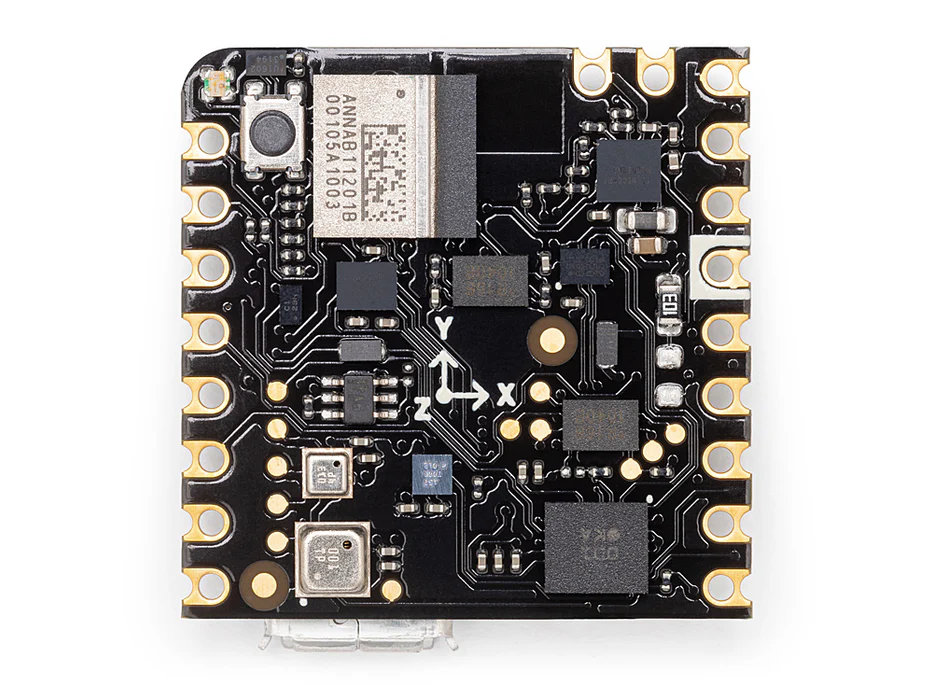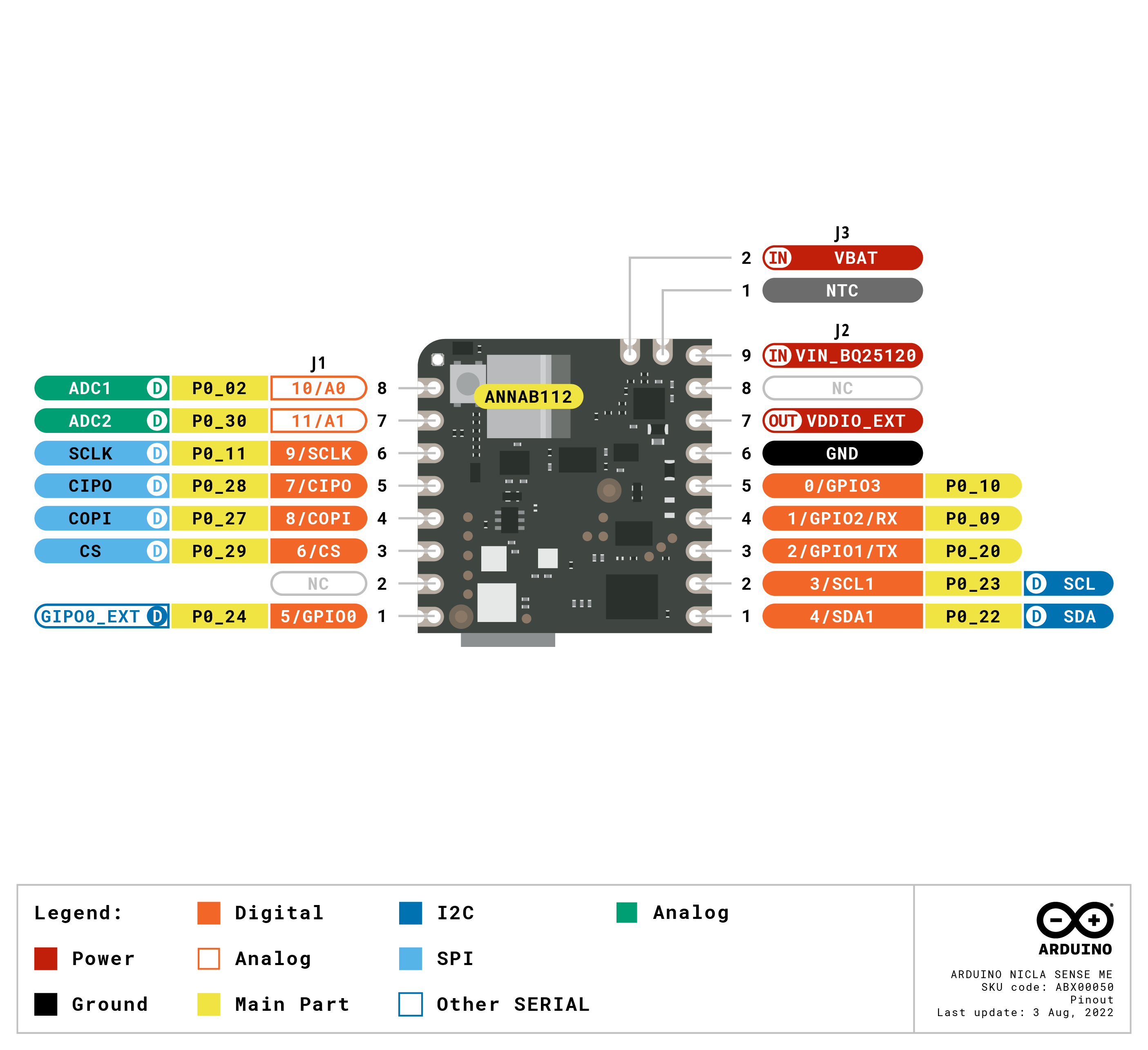
Nicla Sense ME
Bring smart sensing solutions to the edge, with the high-performance, low-power board that packs state-of-the-art Bosch Sensortec technology into our smallest form factor yet.
Overview
The Nicla Sense ME is a tiny, low-power tool that sets a new standard for intelligent sensing solutions. With the simplicity of integration and scalability of the Arduino ecosystem, the board combines four state-of-the-art sensors from Bosch Sensortec:
- BHI260AP motion sensor system with integrated AI
- BMM150 magnetometer
- BMP390 pressure sensor
- BME688 4-in-1 gas sensor with AI and integrated high-linearity, as well as high-accuracy pressure, humidity and temperature sensors.
Designed to easily analyze motion and the surrounding environment – hence the “M” and “E” in the name – it measures rotation, acceleration, pressure, humidity, temperature, air quality and CO2 levels by introducing completely new Bosch Sensortec sensors on the market.
Its tiny size and robust design make it suitable for projects that need to combine sensor fusion and AI capabilities on the edge, thanks to a strong computational power and low-consumption combination that can even lead to standalone applications when battery operated.
Part of Arduino Pro’s new Nicla family of modular, intelligent products that are easy to use, cost effective, versatile and accessible, the Sense ME has a new, tiny form factor that is also compatible with the Arduino MKR and Portenta ranges.
Key benefits
- Tiny size, packed with features
- Low power consumption
- Add sensing capabilities to existing projects
- When battery-powered, becomes a complete standalone board
- Powerful processor, capable of hosting intelligence on the Edge
- Measures motion and environmental parameters
- Robust hardware including industrial-grade sensors with embedded AI
- BLE connectivity maximizes compatibility with professional and consumer equipment
- 24/7 always-on sensor data processing at ultra-low power consumption
Need Help?
Check the Arduino Forum for questions about the Arduino Language, or how to make your own Projects with Arduino. If you need any help with your board, please get in touch with the official Arduino User Support as explained in our Contact Us page.
Warranty
You can find your board warranty information here.
Tech specs
|
Microcontroller |
64 MHz Arm® Cortex M4 (nRF52832) |
|
Sensors |
BHI260AP - Self-learning AI smart sensor with integrated accelerometer and gyroscope, BMP390 - Digital pressure sensor, BMM150 - Geomagnetic sensor, BME688 - Digital low power gas, pressure, temperature & humidity sensor with AI |
|
I/O |
Castellated pins with the following features: 1x I2C bus (with ext. ESLOV connector), 1x serial port, 1x SPI, 2x ADC , programmable I/O voltage from 1.8-3.3V |
|
Connectivity |
Bluetooth® 4.2 |
|
Power |
Micro USB (USB-B), Pin Header, 3.7V Li-po battery with Integrated battery charger |
|
Memory |
512KB Flash / 64KB RAM, 2MB SPI Flash for storage, 2MB QSPI dedicated for BHI260AP |
|
Interface |
USB interface with debug functionality |
|
Dimensions |
22,86 mm x 22,86 mm |
|
Weight |
2 g |
Conformities
Resources for Safety and Products
Manufacturer Information
The production information includes the address and related details of the product manufacturer.
Arduino S.r.l.
Via Andrea Appiani, 25
Monza, MB, IT, 20900
https://www.arduino.cc/
Responsible Person in the EU
An EU-based economic operator who ensures the product's compliance with the required regulations.
Arduino S.r.l.
Via Andrea Appiani, 25
Monza, MB, IT, 20900
Phone: +39 0113157477
Email: support@arduino.cc
Documentation
Learn more
Get Inspired

I have prepare home Automoation project using Arduino nano esp32

There are almost endless variations of clocks for sale on the internet today, but it is still easy to end up in a situation where you can't quite find a model with the style and features you want. Marco Zonca ended up with that problem while searching for a new clock to put in his music studio. Nothing on the market fit the bill, so he built this minimalist network-updated digital clock. Zonca wanted a simple design, the ability to adjust brightness, and NTP (Network Time Protocol) updates. There are clocks available with those features, but nothing in the style Zonca wanted. So he created the perfect clock for himself. It displays 24-hour time across a red LED matrix, lets the user control settings like brightness via Bluetooth® Low Energy communication, and always stays in sync with network time. An Arduino Nano ESP32 board, programmed through Arduino Web Editor, controls all of those functions. It mounts onto a custom PCB that Zonca designed for this clock. The PCB also hosts an 8×32 LED matrix display with MAX7219 driver. Three buttons on the PCB let the user select modes. The PCB fits into a black 3D-printed enclosure that reflects the overall minimalist style. Now Zonca has the perfect clock for his music studio. If you like the look of it, the sketch, PCB files, and 3D enclosure are all available on Hackster.io.










